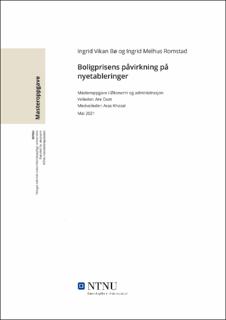| dc.contributor.advisor | Oust, Are | |
| dc.contributor.advisor | Khazal, Aras | |
| dc.contributor.author | Bø, Ingrid Vikan | |
| dc.contributor.author | Romstad, Ingrid Melhus | |
| dc.date.accessioned | 2021-09-22T16:07:01Z | |
| dc.date.available | 2021-09-22T16:07:01Z | |
| dc.date.issued | 2021 | |
| dc.identifier | no.ntnu:inspera:82752696:84758928 | |
| dc.identifier.uri | https://hdl.handle.net/11250/2780546 | |
| dc.description.abstract | Små og mellomstore bedrifter utgjør en viktig del av økonomien i Norge. I løpet av livet vil 90% av nordmenn bo i en selveid bolig og dette kan være en kilde til kapital for gründere. Det vil derfor være verdifullt å undersøke hvordan nyetableringer påvirkes av boligprisen. Formålet med oppgaven er å studere denne sammenhengen, innenfor seks ulike næringer for perioden 2010-2020. Problemstillingen utforskes i lys av teorier om boligmarked, kapitalstruktur og tidligere forskning fra andre land. I analysen brukes både paneldata og tidsserier, og datamaterialene er hentet fra Brønnøysundregisteret, Eiendom Norge, SSB, NAV og Norges Bank. I analysen anvendes en Autoregressive Distributed Lag model (ARDL), som viser variablenes effekt på både kort og lang sikt. Modellen for tidsseriene estimeres ved hjelp av minste kvadraters metode (MKM), og Pooled Mean Group (PMG) for paneldata.
Resultatene indikerer at boligpriser har en signifikant positiv sammenheng med næringene helse- og sosialtjenester og bygge- og anleggsvirksomhet. Næringene industri, varehandel, undervisning og faglig, vitenskapelig og teknisk tjenesteyting viste ingen signifikant sammenheng med boligpriser. Resultatene kan forklares ved å se på virksomheters kapitalbehov, tilgang på finansiering og andre individuelle forskjeller i næringene.
Funnene i denne avhandlingen kan bidra som et supplement til tidligere internasjonal forskning og skape økt kunnskap om forholdet mellom nyetableringer og boligpriser i Norge. | |
| dc.description.abstract | Small and medium-sized businesses are an important part of the economy in Norway. During their lifetime, 90% of Norwegians will live in a self-owned home, and this can be a source of capital for entrepreneurs. It will therefore be valuable to examine how new start-up companies are affected by house prices. The purpose of the thesis is to analyze this relationship within six different industries for the period of 2010-2020. The thesis statement is explored in light of theories about the housing market, capital structure for start-up companies and previous research from other countries. The analysis uses both panel data and time series, and the data are gathered from the Brønnøysund Register Centre, Real Estate Norway, Statistics Norway, NAV and the Central Bank of Norway. The analysis uses an Autoregressive Distributed Lag model (ARDL), which shows both the short and long run effect of the variables. The model for the time series is estimated using Ordinary least squares regression (OLS), and the Pooled Mean Group (PMG) estimator is applied for the panel data.
The results indicate that house prices have a significant positive relationship with the industries human health and social work activities and construction. The industries manufacturing, wholesale and retail trade, education and professional, scientific and technical activities showed no significant correlation with the house prices. This can be explained by looking at companies' capital needs, access to funding and other individual differences in the industries.
The findings in the thesis can contribute as an addition to the previous international research, as well as creating more knowledge about the relationship between start-up companies and house prices in Norway. | |
| dc.language | nob | |
| dc.publisher | NTNU | |
| dc.title | Boligprisens påvirkning på nyetableringer | |
| dc.type | Master thesis | |
